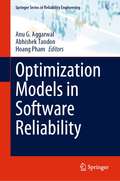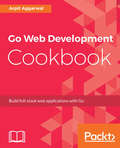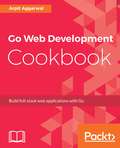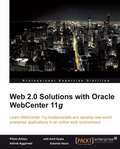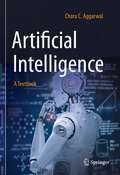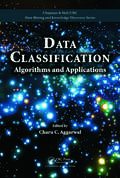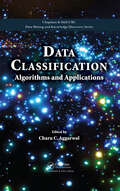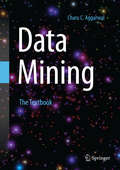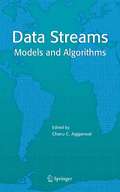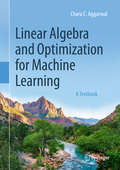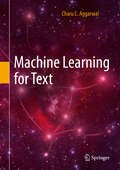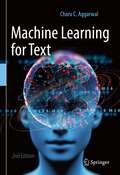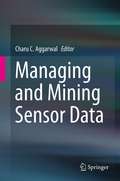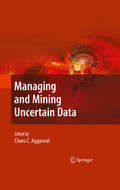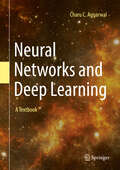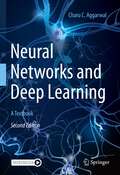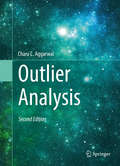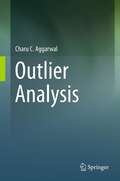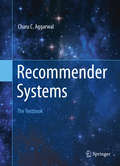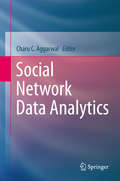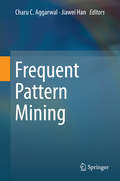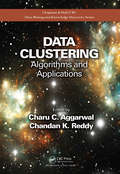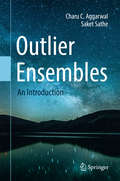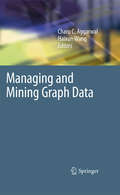- Table View
- List View
Optimization Models in Software Reliability (Springer Series in Reliability Engineering)
by Anu G. Aggarwal Abhishek Tandon Hoang PhamThe book begins with an introduction to software reliability, models and techniques. The book is an informative book covering the strategies needed to assess software failure behaviour and its quality, as well as the application of optimization tools for major managerial decisions related to the software development process. It features a broad range of topics including software reliability assessment and apportionment, optimal allocation and selection decisions and upgradations problems. It moves through a variety of problems related to the evolving field of optimization of software reliability engineering, including software release time, resource allocating, budget planning and warranty models, which are each explored in depth in dedicated chapters. This book provides a comprehensive insight into present-day practices in software reliability engineering, making it relevant to students, researchers, academics and practising consultants and engineers.
Go Web Development Cookbook: Build Full-stack Web Applications With Go
by Arpit Aggarwal86 recipes on how to build fast, scalable, and powerful web services and applications with GoAbout This BookBecome proficient in RESTful web servicesBuild scalable, high-performant web applications in GoGet acquainted with Go frameworks for web developmentWho This Book Is ForThis book is for Go developers interested in learning how to use Go to build powerful web applications. A background in web development is expected.What You Will LearnCreate a simple HTTP and TCP web server and understand how it worksExplore record in a MySQL and MongoDB databaseWrite and consume RESTful web service in GoInvent microservices in Go using Micro – a microservice toolkitCreate and Deploy the Beego application with NginxDeploy Go web application and Docker containers on an AWS EC2 instanceIn DetailGo is an open source programming language that is designed to scale and support concurrency at the language level. This gives you the liberty to write large concurrent web applications with ease. From creating web application to deploying them on Amazon Cloud Services, this book will be your one-stop guide to learn web development in Go. The Go Web Development Cookbook teaches you how to create REST services, write microservices, and deploy Go Docker containers. Whether you are new to programming or a professional developer, this book will help get you up to speed with web development in Go. We will focus on writing modular code in Go; in-depth informative examples build the base, one step at a time. You will learn how to create a server, work with static files, SQL, NoSQL databases, and Beego. You will also learn how to create and secure REST services, and create and deploy Go web application and Go Docker containers on Amazon Cloud Services. By the end of the book, you will be able to apply the skills you've gained in Go to create and explore web applications in any domain.Style and approachThis book helps you learn core Go concepts faster by taking a recipe-based approach.
Web 2.0 Solutions with Oracle WebCenter 11g: Learn Webcenter 11g Fundamentals And Develop Real-world Enterprise Applications In An Online Work Environment
by Ashok Aggarwal Plinio ArbizuThe book starts by explaining the context of the WEB 2.0 platform. It helps the reader to understand its main features and their application in organizations. It shows how the Oracle WebCenter technology can help you implement the Web 2.0 solutions. In each chapter, the theoretical concepts are tested with the help of practical applications. The apt recommendations and suggestions are other key points of the book. Filled with careful step-by-step instructions and plenty of screenshots, this tutorial shows you how to get the most out of the WebCenter Suite 11g. You will learn about integrating various services to enhance your Web 2.0 solutions using Oracle WebCenter.This book is for web developers who need to improve their websites or business applications using Web 2.0 features.This book is recommended for you, if you are a: Portal Developer who works with a traditional portal and wants to move onto new technologies, Java Developer and want to add productivity features to your business applications, Knowledge Managers and want to create collaborative environments and increase the productivity of your employees and organizational groups
Artificial Intelligence: A Textbook
by Charu C. AggarwalThis textbook covers the broader field of artificial intelligence. The chapters for this textbook span within three categories:Deductive reasoning methods: These methods start with pre-defined hypotheses and reason with them in order to arrive at logically sound conclusions. The underlying methods include search and logic-based methods. These methods are discussed in Chapters 1through 5.Inductive Learning Methods: These methods start with examples and use statistical methods in order to arrive at hypotheses. Examples include regression modeling, support vector machines, neural networks, reinforcement learning, unsupervised learning, and probabilistic graphical models. These methods are discussed in Chapters~6 through 11. Integrating Reasoning and Learning: Chapters~11 and 12 discuss techniques for integrating reasoning and learning. Examples include the use of knowledge graphs and neuro-symbolic artificial intelligence.The primary audience for this textbook are professors and advanced-level students in computer science. It is also possible to use this textbook for the mathematics requirements for an undergraduate data science course. Professionals working in this related field many also find this textbook useful as a reference.
Data Classification: Algorithms and Applications
by Charu C. AggarwalComprehensive Coverage of the Entire Area of ClassificationResearch on the problem of classification tends to be fragmented across such areas as pattern recognition, database, data mining, and machine learning. Addressing the work of these different communities in a unified way, Data Classification: Algorithms and Applications explores the underlyi
Data Classification: Algorithms and Applications (Chapman And Hall/crc Data Mining And Knowledge Discovery Ser. #35)
by Charu C. AggarwalComprehensive Coverage of the Entire Area of ClassificationResearch on the problem of classification tends to be fragmented across such areas as pattern recognition, database, data mining, and machine learning. Addressing the work of these different communities in a unified way, Data Classification: Algorithms and Applications explores the underlyi
Data Mining: The Textbook (Chapman And Hall/crc Data Mining And Knowledge Discovery Ser. #31)
by Charu C. AggarwalThis textbook explores the different aspects of data mining from the fundamentals to the complex data types and their applications, capturing the wide diversity of problem domains for data mining issues. It goes beyond the traditional focus on data mining problems to introduce advanced data types such as text, time series, discrete sequences, spatial data, graph data, and social networks. Until now, no single book has addressed all these topics in a comprehensive and integrated way. The chapters of this book fall into one of three categories: Fundamental chapters: Data mining has four main problems, which correspond to clustering, classification, association pattern mining, and outlier analysis. These chapters comprehensively discuss a wide variety of methods for these problems. Domain chapters: These chapters discuss the specific methods used for different domains of data such as text data, time-series data, sequence data, graph data, and spatial data. Application chapters: These chapters study important applications such as stream mining, Web mining, ranking, recommendations, social networks, and privacy preservation. The domain chapters also have an applied flavor. Appropriate for both introductory and advanced data mining courses, Data Mining: The Textbook balances mathematical details and intuition. It contains the necessary mathematical details for professors and researchers, but it is presented in a simple and intuitive style to improve accessibility for students and industrial practitioners (including those with a limited mathematical background). Numerous illustrations, examples, and exercises are included, with an emphasis on semantically interpretable examples.Praise for Data Mining: The Textbook - “As I read through this book, I have already decided to use it in my classes. This is a book written by an outstanding researcher who has made fundamental contributions to data mining, in a way that is both accessible and up to date. The book is complete with theory and practical use cases. It’s a must-have for students and professors alike!" -- Qiang Yang, Chair of Computer Science and Engineering at Hong Kong University of Science and Technology"This is the most amazing and comprehensive text book on data mining. It covers not only the fundamental problems, such as clustering, classification, outliers and frequent patterns, and different data types, including text, time series, sequences, spatial data and graphs, but also various applications, such as recommenders, Web, social network and privacy. It is a great book for graduate students and researchers as well as practitioners." -- Philip S. Yu, UIC Distinguished Professor and Wexler Chair in Information Technology at University of Illinois at Chicago
Data Streams: Models and Algorithms (Advances in Database Systems #31)
by Charu C. AggarwalThis book primarily discusses issues related to the mining aspects of data streams and it is unique in its primary focus on the subject. This volume covers mining aspects of data streams comprehensively: each contributed chapter contains a survey on the topic, the key ideas in the field for that particular topic, and future research directions. The book is intended for a professional audience composed of researchers and practitioners in industry. This book is also appropriate for advanced-level students in computer science.
Linear Algebra and Optimization for Machine Learning: A Textbook
by Charu C. AggarwalThis textbook introduces linear algebra and optimization in the context of machine learning. Examples and exercises are provided throughout this text book together with access to a solution’s manual. This textbook targets graduate level students and professors in computer science, mathematics and data science. Advanced undergraduate students can also use this textbook. The chapters for this textbook are organized as follows:1. Linear algebra and its applications: The chapters focus on the basics of linear algebra together with their common applications to singular value decomposition, matrix factorization, similarity matrices (kernel methods), and graph analysis. Numerous machine learning applications have been used as examples, such as spectral clustering, kernel-based classification, and outlier detection. The tight integration of linear algebra methods with examples from machine learning differentiates this book from generic volumes on linear algebra. The focus is clearly on the most relevant aspects of linear algebra for machine learning and to teach readers how to apply these concepts.2. Optimization and its applications: Much of machine learning is posed as an optimization problem in which we try to maximize the accuracy of regression and classification models. The “parent problem” of optimization-centric machine learning is least-squares regression. Interestingly, this problem arises in both linear algebra and optimization, and is one of the key connecting problems of the two fields. Least-squares regression is also the starting point for support vector machines, logistic regression, and recommender systems. Furthermore, the methods for dimensionality reduction and matrix factorization also require the development of optimization methods. A general view of optimization in computational graphs is discussed together with its applications to back propagation in neural networks. A frequent challenge faced by beginners in machine learning is the extensive background required in linear algebra and optimization. One problem is that the existing linear algebra and optimization courses are not specific to machine learning; therefore, one would typically have to complete more course material than is necessary to pick up machine learning. Furthermore, certain types of ideas and tricks from optimization and linear algebra recur more frequently in machine learning than other application-centric settings. Therefore, there is significant value in developing a view of linear algebra and optimization that is better suited to the specific perspective of machine learning.
Machine Learning for Text
by Charu C. AggarwalText analytics is a field that lies on the interface of information retrieval,machine learning, and natural language processing, and this textbook carefully covers a coherently organized framework drawn from these intersecting topics. The chapters of this textbook is organized into three categories:- Basic algorithms: Chapters 1 through 7 discuss the classical algorithms for machine learning from text such as preprocessing, similarity computation, topic modeling, matrix factorization, clustering, classification, regression, and ensemble analysis.- Domain-sensitive mining: Chapters 8 and 9 discuss the learning methods from text when combined with different domains such as multimedia and the Web. The problem of information retrieval and Web search is also discussed in the context of its relationship with ranking and machine learning methods. - Sequence-centric mining: Chapters 10 through 14 discuss various sequence-centric and natural language applications, such as feature engineering, neural language models, deep learning, text summarization, information extraction, opinion mining, text segmentation, and event detection. This textbook covers machine learning topics for text in detail. Since the coverage is extensive,multiple courses can be offered from the same book, depending on course level. Even though the presentation is text-centric, Chapters 3 to 7 cover machine learning algorithms that are often used indomains beyond text data. Therefore, the book can be used to offer courses not just in text analytics but also from the broader perspective of machine learning (with text as a backdrop). This textbook targets graduate students in computer science, as well as researchers, professors, and industrial practitioners working in these related fields. This textbook is accompanied with a solution manual for classroom teaching.
Machine Learning for Text
by Charu C. AggarwalThis second edition textbook covers a coherently organized framework for text analytics, which integrates material drawn from the intersecting topics of information retrieval, machine learning, and natural language processing. Particular importance is placed on deep learning methods. The chapters of this book span three broad categories:1. Basic algorithms: Chapters 1 through 7 discuss the classical algorithms for text analytics such as preprocessing, similarity computation, topic modeling, matrix factorization, clustering, classification, regression, and ensemble analysis.2. Domain-sensitive learning and information retrieval: Chapters 8 and 9 discuss learning models in heterogeneous settings such as a combination of text with multimedia or Web links. The problem of information retrieval and Web search is also discussed in the context of its relationship with ranking and machine learning methods. 3. Natural language processing: Chapters 10 through 16 discuss various sequence-centric and natural language applications, such as feature engineering, neural language models, deep learning, transformers, pre-trained language models, text summarization, information extraction, knowledge graphs, question answering, opinion mining, text segmentation, and event detection. Compared to the first edition, this second edition textbook (which targets mostly advanced level students majoring in computer science and math) has substantially more material on deep learning and natural language processing. Significant focus is placed on topics like transformers, pre-trained language models, knowledge graphs, and question answering.
Managing and Mining Sensor Data
by Charu C. AggarwalAdvances in hardware technology have lead to an ability to collect data with the use of a variety of sensor technologies. In particular sensor notes have become cheaper and more efficient, and have even been integrated into day-to-day devices of use, such as mobile phones. This has lead to a much larger scale of applicability and mining of sensor data sets. The human-centric aspect of sensor data has created tremendous opportunities in integrating social aspects of sensor data collection into the mining process. Managing and Mining Sensor Data is a contributed volume by prominent leaders in this field, targeting advanced-level students in computer science as a secondary text book or reference. Practitioners and researchers working in this field will also find this book useful.
Managing and Mining Uncertain Data (Advances in Database Systems #35)
by Charu C. AggarwalManaging and Mining Uncertain Data, a survey with chapters by a variety of well known researchers in the data mining field, presents the most recent models, algorithms, and applications in the uncertain data mining field in a structured and concise way. This book is organized to make it more accessible to applications-driven practitioners for solving real problems. Also, given the lack of structurally organized information on this topic, Managing and Mining Uncertain Data provides insights which are not easily accessible elsewhere. Managing and Mining Uncertain Data is designed for a professional audience composed of researchers and practitioners in industry. This book is also suitable as a reference book for advanced-level students in computer science and engineering, as well as the ACM, IEEE, SIAM, INFORMS and AAAI Society groups.
Neural Networks and Deep Learning: A Textbook
by Charu C. AggarwalThis book covers both classical and modern models in deep learning. The primary focus is on the theory and algorithms of deep learning. The theory and algorithms of neural networks are particularly important for understanding important concepts, so that one can understand the important design concepts of neural architectures in different applications. Why do neural networks work? When do they work better than off-the-shelf machine-learning models? When is depth useful? Why is training neural networks so hard? What are the pitfalls? The book is also rich in discussing different applications in order to give the practitioner a flavor of how neural architectures are designed for different types of problems. Applications associated with many different areas like recommender systems, machine translation, image captioning, image classification, reinforcement-learning based gaming, and text analytics are covered. The chapters of this book span three categories: The basics of neural networks: Many traditional machine learning models can be understood as special cases of neural networks. An emphasis is placed in the first two chapters on understanding the relationship between traditional machine learning and neural networks. Support vector machines, linear/logistic regression, singular value decomposition, matrix factorization, and recommender systems are shown to be special cases of neural networks. These methods are studied together with recent feature engineering methods like word2vec. Fundamentals of neural networks: A detailed discussion of training and regularization is provided in Chapters 3 and 4. Chapters 5 and 6 present radial-basis function (RBF) networks and restricted Boltzmann machines. Advanced topics in neural networks: Chapters 7 and 8 discuss recurrent neural networks and convolutional neural networks. Several advanced topics like deep reinforcement learning, neural Turing machines, Kohonen self-organizing maps, and generative adversarial networks are introduced in Chapters 9 and 10. The book is written for graduate students, researchers, and practitioners. Numerous exercises are available along with a solution manual to aid in classroom teaching. Where possible, an application-centric view is highlighted in order to provide an understanding of the practical uses of each class of techniques.
Neural Networks and Deep Learning: A Textbook
by Charu C. AggarwalThis book covers both classical and modern models in deep learning. The primary focus is on the theory and algorithms of deep learning. The theory and algorithms of neural networks are particularly important for understanding important concepts, so that one can understand the important design concepts of neural architectures in different applications. Why do neural networks work? When do they work better than off-the-shelf machine-learning models? When is depth useful? Why is training neural networks so hard? What are the pitfalls? The book is also rich in discussing different applications in order to give the practitioner a flavor of how neural architectures are designed for different types of problems. Deep learning methods for various data domains, such as text, images, and graphs are presented in detail. The chapters of this book span three categories: The basics of neural networks: The backpropagation algorithm is discussed in Chapter 2.Many traditional machine learning models can be understood as special cases of neural networks. Chapter 3 explores the connections between traditional machine learning and neural networks. Support vector machines, linear/logistic regression, singular value decomposition, matrix factorization, and recommender systems are shown to be special cases of neural networks. Fundamentals of neural networks: A detailed discussion of training and regularization is provided in Chapters 4 and 5. Chapters 6 and 7 present radial-basis function (RBF) networks and restricted Boltzmann machines. Advanced topics in neural networks: Chapters 8, 9, and 10 discuss recurrent neural networks, convolutional neural networks, and graph neural networks. Several advanced topics like deep reinforcement learning, attention mechanisms, transformer networks, Kohonen self-organizing maps, and generative adversarial networks are introduced in Chapters 11 and 12. The textbook is written for graduate students and upper under graduate level students. Researchers and practitioners working within this related field will want to purchase this as well.Where possible, an application-centric view is highlighted in order to provide an understanding of the practical uses of each class of techniques.The second edition is substantially reorganized and expanded with separate chapters on backpropagation and graph neural networks. Many chapters have been significantly revised over the first edition.Greater focus is placed on modern deep learning ideas such as attention mechanisms, transformers, and pre-trained language models.
Outlier Analysis
by Charu C. AggarwalThis book provides comprehensive coverage of the field of outlier analysis from a computer science point of view. It integrates methods from data mining, machine learning, and statistics within the computational framework and therefore appeals to multiple communities. The chapters of this book can be organized into three categories:Basic algorithms: Chapters 1 through 7 discuss the fundamental algorithms for outlier analysis, including probabilistic and statistical methods, linear methods, proximity-based methods, high-dimensional (subspace) methods, ensemble methods, and supervised methods.Domain-specific methods: Chapters 8 through 12 discuss outlier detection algorithms for various domains of data, such as text, categorical data, time-series data, discrete sequence data, spatial data, and network data.Applications: Chapter 13 is devoted to various applications of outlier analysis. Some guidance is also provided for the practitioner.The second edition of this book is more detailed and is written to appeal to both researchers and practitioners. Significant new material has been added on topics such as kernel methods, one-class support-vector machines, matrix factorization, neural networks, outlier ensembles, time-series methods, and subspace methods. It is written as a textbook and can be used for classroom teaching.
Outlier Analysis
by Charu C. AggarwalWith the increasing advances in hardware technology for data collection, and advances in software technology (databases) for data organization, computer scientists have increasingly participated in the latest advancements of the outlier analysis field. Computer scientists, specifically, approach this field based on their practical experiences in managing large amounts of data, and with far fewer assumptions– the data can be of any type, structured or unstructured, and may be extremely large. Outlier Analysis is a comprehensive exposition, as understood by data mining experts, statisticians and computer scientists. The book has been organized carefully, and emphasis was placed on simplifying the content, so that students and practitioners can also benefit. Chapters will typically cover one of three areas: methods and techniques commonly used in outlier analysis, such as linear methods, proximity-based methods, subspace methods, and supervised methods; data domains, such as, text, categorical, mixed-attribute, time-series, streaming, discrete sequence, spatial and network data; and key applications of these methods as applied to diverse domains such as credit card fraud detection, intrusion detection, medical diagnosis, earth science, web log analytics, and social network analysis are covered.
Recommender Systems: The Textbook
by Charu C. AggarwalThis book comprehensively covers the topic of recommender systems, which provide personalized recommendations of products or services to users based on their previous searches or purchases. Recommender system methods have been adapted to diverse applications including query log mining, social networking, news recommendations, and computational advertising. This book synthesizes both fundamental and advanced topics of a research area that has now reached maturity. The chapters of this book are organized into three categories: Algorithms and evaluation: These chapters discuss the fundamental algorithms in recommender systems, including collaborative filtering methods, content-based methods, knowledge-based methods, ensemble-based methods, and evaluation. Recommendations in specific domains and contexts: the context of a recommendation can be viewed as important side information that affects the recommendation goals. Different types of context such as temporal data, spatial data, social data, tagging data, and trustworthiness are explored. Advanced topics and applications: Various robustness aspects of recommender systems, such as shilling systems, attack models, and their defenses are discussed. In addition, recent topics, such as learning to rank, multi-armed bandits, group systems, multi-criteria systems, and active learning systems, are introduced together with applications. Although this book primarily serves as a textbook, it will also appeal to industrial practitioners and researchers due to its focus on applications and references. Numerous examples and exercises have been provided, and a solution manual is available for instructors.
Social Network Data Analytics
by Charu C. AggarwalSocial network analysis applications have experienced tremendous advances within the last few years due in part to increasing trends towards users interacting with each other on the internet. Social networks are organized as graphs, and the data on social networks takes on the form of massive streams, which are mined for a variety of purposes. Social Network Data Analytics covers an important niche in the social network analytics field. This edited volume, contributed by prominent researchers in this field, presents a wide selection of topics on social network data mining such as Structural Properties of Social Networks, Algorithms for Structural Discovery of Social Networks and Content Analysis in Social Networks. This book is also unique in focussing on the data analytical aspects of social networks in the internet scenario, rather than the traditional sociology-driven emphasis prevalent in the existing books, which do not focus on the unique data-intensive characteristics of online social networks. Emphasis is placed on simplifying the content so that students and practitioners benefit from this book. This book targets advanced level students and researchers concentrating on computer science as a secondary text or reference book. Data mining, database, information security, electronic commerce and machine learning professionals will find this book a valuable asset, as well as primary associations such as ACM, IEEE and Management Science.
Frequent Pattern Mining
by Charu C. Aggarwal Jiawei HanThis comprehensive reference consists of 18 chapters from prominent researchers in the field. Each chapter is self-contained, and synthesizes one aspect of frequent pattern mining. An emphasis is placed on simplifying the content, so that students and practitioners can benefit from the book. Each chapter contains a survey describing key research on the topic, a case study and future directions. Key topics include: Pattern Growth Methods, Frequent Pattern Mining in Data Streams, Mining Graph Patterns, Big Data Frequent Pattern Mining, Algorithms for Data Clustering and more. Advanced-level students in computer science, researchers and practitioners from industry will find this book an invaluable reference.
Data Clustering: Algorithms and Applications (Chapman & Hall/CRC Data Mining and Knowledge Discovery Series)
by Charu C. Aggarwal Chandan K. ReddyResearch on the problem of clustering tends to be fragmented across the pattern recognition, database, data mining, and machine learning communities. Addressing this problem in a unified way, Data Clustering: Algorithms and Applications provides complete coverage of the entire area of clustering, from basic methods to more refined and complex data clustering approaches. It pays special attention to recent issues in graphs, social networks, and other domains.The book focuses on three primary aspects of data clustering: Methods, describing key techniques commonly used for clustering, such as feature selection, agglomerative clustering, partitional clustering, density-based clustering, probabilistic clustering, grid-based clustering, spectral clustering, and nonnegative matrix factorization Domains, covering methods used for different domains of data, such as categorical data, text data, multimedia data, graph data, biological data, stream data, uncertain data, time series clustering, high-dimensional clustering, and big data Variations and Insights, discussing important variations of the clustering process, such as semisupervised clustering, interactive clustering, multiview clustering, cluster ensembles, and cluster validation In this book, top researchers from around the world explore the characteristics of clustering problems in a variety of application areas. They also explain how to glean detailed insight from the clustering process—including how to verify the quality of the underlying clusters—through supervision, human intervention, or the automated generation of alternative clusters.
Data Clustering: Algorithms and Applications (Chapman & Hall/CRC Data Mining and Knowledge Discovery Series #31)
by Charu C. Aggarwal Chandan K. ReddyResearch on the problem of clustering tends to be fragmented across the pattern recognition, database, data mining, and machine learning communities. Addressing this problem in a unified way, Data Clustering: Algorithms and Applications provides complete coverage of the entire area of clustering, from basic methods to more refined and complex data clustering approaches. It pays special attention to recent issues in graphs, social networks, and other domains.The book focuses on three primary aspects of data clustering: Methods, describing key techniques commonly used for clustering, such as feature selection, agglomerative clustering, partitional clustering, density-based clustering, probabilistic clustering, grid-based clustering, spectral clustering, and nonnegative matrix factorization Domains, covering methods used for different domains of data, such as categorical data, text data, multimedia data, graph data, biological data, stream data, uncertain data, time series clustering, high-dimensional clustering, and big data Variations and Insights, discussing important variations of the clustering process, such as semisupervised clustering, interactive clustering, multiview clustering, cluster ensembles, and cluster validation In this book, top researchers from around the world explore the characteristics of clustering problems in a variety of application areas. They also explain how to glean detailed insight from the clustering process—including how to verify the quality of the underlying clusters—through supervision, human intervention, or the automated generation of alternative clusters.
Outlier Ensembles: An Introduction
by Charu C. Aggarwal Saket SatheThis book discusses a variety of methods for outlier ensembles and organizes them by the specific principles with which accuracy improvements are achieved. In addition, it covers the techniques with which such methods can be made more effective. A formal classification of these methods is provided, and the circumstances in which they work well are examined. The authors cover how outlier ensembles relate (both theoretically and practically) to the ensemble techniques used commonly for other data mining problems like classification. The similarities and (subtle) differences in the ensemble techniques for the classification and outlier detection problems are explored. These subtle differences do impact the design of ensemble algorithms for the latter problem. This book can be used for courses in data mining and related curricula. Many illustrative examples and exercises are provided in order to facilitate classroom teaching. A familiarity is assumed to the outlier detection problem and also to generic problem of ensemble analysis in classification. This is because many of the ensemble methods discussed in this book are adaptations from their counterparts in the classification domain. Some techniques explained in this book, such as wagging, randomized feature weighting, and geometric subsampling, provide new insights that are not available elsewhere. Also included is an analysis of the performance of various types of base detectors and their relative effectiveness. The book is valuable for researchers and practitioners for leveraging ensemble methods into optimal algorithmic design.
Managing and Mining Graph Data (Advances in Database Systems #40)
by Charu C. Aggarwal Haixun WangManaging and Mining Graph Data is a comprehensive survey book in graph management and mining. It contains extensive surveys on a variety of important graph topics such as graph languages, indexing, clustering, data generation, pattern mining, classification, keyword search, pattern matching, and privacy. It also studies a number of domain-specific scenarios such as stream mining, web graphs, social networks, chemical and biological data. The chapters are written by well known researchers in the field, and provide a broad perspective of the area. This is the first comprehensive survey book in the emerging topic of graph data processing. Managing and Mining Graph Data is designed for a varied audience composed of professors, researchers and practitioners in industry. This volume is also suitable as a reference book for advanced-level database students in computer science and engineering.
